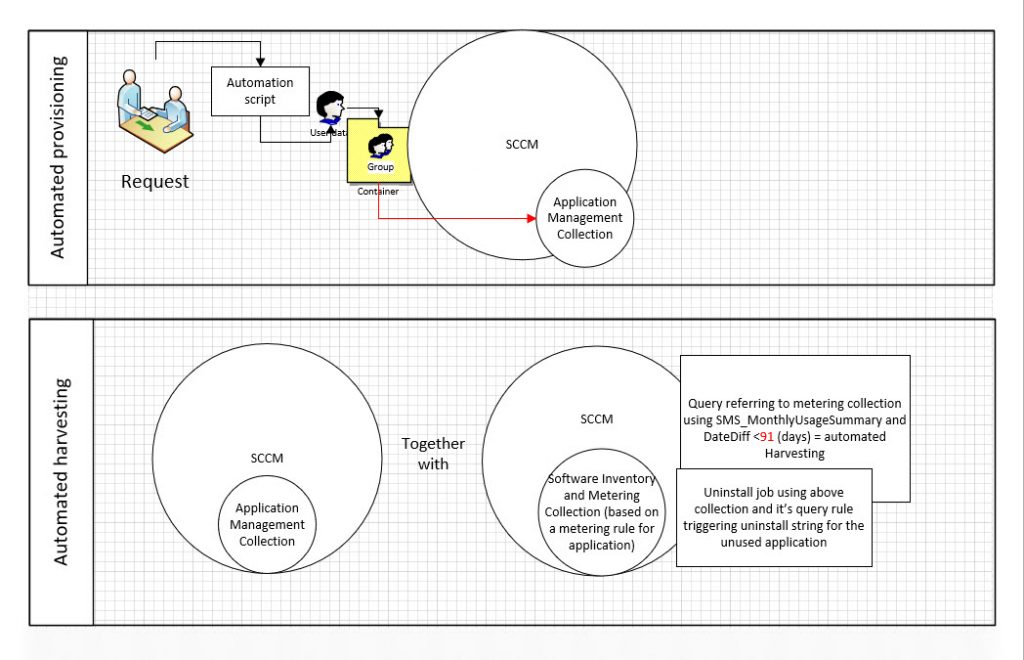One of this forums users have asked the other day:
“I have a question regarding automatic un-install of software that is not in use for more than 90 days, if you are practicing that and if yes, could you share info on what type of tool you use, do you inform the end users first before un-installing the the software? “
Firstly, we use Global approach to everything. We are located in many countries and so licensing could become a nightmare.
This is why we are not only registering entitlements (registering is essential for reconciliation though), we actually define and build them into our infrastructure as a system in each “service” case.
We have defined all sites in AD, all locations, all normal types of restrictions and the structure is based on basic limitations of license entitlement: computer/user, site, country, region, or globe.
SCCM and all other systems alike mirror this, which of course more or less corresponds to the information in master data.
Secondly, we have a Global policy corresponding to the situation at hand like Harvesting. Our users know of it and are referred to it when software is removed. Helpdesk can easily do that once it’s in place. There are two versions of it, the main version explaining everything, and the short version, which can easily be provided to users. Additionally functionality in both SCCM and Orchestrator can be used for requesting / provisioning and notifications to some degree. Of course users sometimes don’t remember what happened after the fact, but that’s the case every other Monday and passwords too.
We utilize a tool with CMDB capabilities as front, which presents users with a standard form, allowing them to choose from available software services. We have several such tools as we are transitioning from one main tool to another while tickets also need to be managed somewhere. This tool also contains master data copy which uniquely identifies the user and the service as well as many other things like locations, sites, contracts and much much more.
The “software service” is defined through a service database which allows us with a rather friendly form to define these services in terms of which AD containers they regard, how they are restricted, who approves, what they cost, who possesses knowledge and much more.
This is where definition of the entitlement comes in. Entitlement is translated into a service in implementation. We know what we have purchased, where it is possible to use, how it can be used and so we restrict this usage accordingly and then add the output in this database. When users are requesting a “software” in this database, they are choosing a package which is predefined, pointing to a specific server, or using pooled license information, a cloud service or whatever else. Technically they are choosing a compliant already service or software, defined specifically for them, their location or region, shown only where allowed to be used.
AD allows us to control who has access and who doesn’t. Each add-on or removal is recorded with a stamp of the “request” for that particular service, time and date and other information giving traceability and thus enabling a short process of SOX compliance audits internally.
Each package is named to reflect it’s intended deployment “region”, so are the AD groups used and collections. AppDeployToolkit allows for parsing some messaging to users at install/un-install and functionality allowing user to choose a better moment for any actions.
The rest of the magic happens in SCCM which we utilize heavily.
I’ve drawn here a simple likeness of how this works with both provisioning and harvesting. Each and every step allows for roll-back, un-install, install, update or “otherwise”; allows for targeting of specific groups of users / computers or services.

Every action which we perform when implementing or managing is recorded and at a point translated into an SOP; which is periodically refreshed.
This to ensure everyone, with disregard to their location or specific focus can do anything technically as well as making sure we always do everything the same way.
Every standard has been agreed on and recorded as well. This ensures common way of defining “anything” the same way, according to the same principles making everything reproducible and transparent.
The aim is to reach a level of automation which allows for almost a 0 touch approach to maintaining daily operations and focusing on two items. Implementation on one end and continues service improvement on the other.
That’s what we call SAM 5.0, an almost autonomous, self improving service delivering software, preconfigured, licensed and yet always compliant, my idea of heaven.